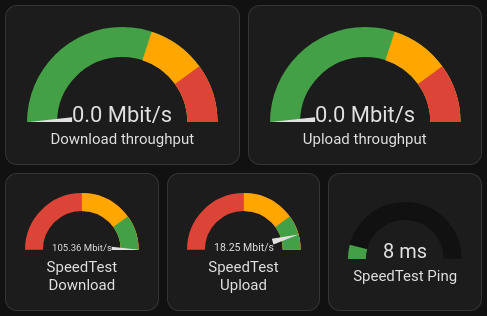

This is the reason I haven’t gone down the smart light switches path yet.
Anything that I’d trust enough on 240v is out of budget!


This is the reason I haven’t gone down the smart light switches path yet.
Anything that I’d trust enough on 240v is out of budget!


It definitely threw me the first time I was out of the house.
I decided the best solution was just to limit alerts to non-sensitive things.
While I’m generally very big on privacy, I really don’t give a monkeys if Apple/Google is relaying a message that says “Cat in garden!”


This is a really nice guide, and covers everything from source source to sea, so to speak.
Ideal for someone installing for the first time, thanks for sharing!


Security wise, while I love automating everything, I personally would just give them a physical key to the front door. (Or an RFID keyfob system).
What you’d be achieving is the equivalent of keyless car entry, with the additional downside that your son can’t choose not to open the door if something sketchy happens.
And instead of entrusting them with a traditional key that they can treat responsibly, you’re just putting something in their backpack that they don’t have to think about.
If you really want to do it, basically anything in homeassistant that has wireless capability and a state would probably work.
A zigbee radio, and pretty much any device doing anything would do it.
When device_name becomes available, activate door opening.
That’s a pretty neat bit of kit. If they did it in metric sizes, I’d be tempted.
Your meter may have some kind of magnetic flux that occurs as the dial spins, which you might be able to sense and interpret.
I’m curious to hear what people come up with, as I quite fancy one too.
I would be wary of installing anything that actually touches the water that doesn’t come from an accredited manufacturer, however. As you don’t want Ali-express grade metal in your drinking water.
Which unfortunately means the options will be either expensive, or building off the back of other equipment currently installed (water meter, etc).
It was broken for a few weeks of 2024.2 (I think). I ended up learning how to do a manual downgrade while they fixed it!


Asking questions is always good, don’t worry! Feel free to ask more, heck update the thread and ask questions as you go along if you like.
If you list the devices you want to migrate, I’m sure the community will happily highlight any tips, or which will be the easiest to get you started.
It is indeed! Mostly just fiddling around with the settings.
@smeg@feddit.uk, here is a paste of the config so you can play with it:
(If you click show code editor, then paste in, you can then go back to visual editor with things configured)
Speedtest needle gauges and ping with colour change:
type: horizontal-stack
cards:
- type: gauge
min: 0
severity:
green: 80
yellow: 50
red: 0
entity: sensor.speedtest_download
max: 100
needle: true
- type: gauge
min: 0
max: 20
entity: sensor.speedtest_upload
severity:
green: 16
yellow: 10
red: 0
needle: true
- type: gauge
min: 0
entity: sensor.speedtest_ping
severity:
green: 0
yellow: 15
red: 20
max: 100
Air quality with lots of different colours:
type: horizontal-stack
cards:
- type: gauge
entity: sensor.oxford_air_quality_index
needle: false
min: 0
max: 500
segments:
- from: 0
color: '#00e400'
- from: 51
color: '#ffff00'
- from: 101
color: '#ff7e00'
- from: 151
color: '#ff0000'
- from: 201
color: '#8f3f97'
- from: 301
color: '#800000'
name: 'Air quality: PM2.5'
unit: µg/m3
- type: gauge
entity: sensor.external_environment_f
max: 40
severity:
green: 18
yellow: 25
red: 30
needle: false
min: -10
- type: gauge
entity: sensor.oxford_uv_index
max: 10
severity:
green: 0
yellow: 3
red: 6
Once you’ve got your head around horizontal stacks (lets you put multiple small dials together), it’s mostly picking thresholds and settings colours.


Currently, it’s using a Waze integration.
The coolest thing, is that it’s given me a really nice data set for when are the bad times to drive across town are. (Sadly, it’s during the morning and afternoon school runs).
It also reveals that the travel time on average is impacted significantly by the school holidays, and the weather.



My “What’s the internet connection up to?” card:

My “Leaving the house” card:

It’s nice to compare the local predicted temperature, and local sensor.
Ah, the Season 4 finale of For All Mankind.


Haha, I have no idea. Possibly less corporate, more “small, simple, open system that others can contribute to”.
I can only speak in vagueness on the “european-ness”, to be honest.
HASS/Zigbee have an open, european feel to me.
HomeSeer has a very american “this is the way we’re doing it, it costs this much” feel.
Backblaze also expand in that article, detailing the 3-2-1-1-0 as a successor to 3-2-1.
I think for me, it’s because it’s sort-of (though not!) self-archiving.
If a site has a reasonable amount of popularity and subscriptions, it would take that site going down, plus all the sites that communicated with it, for the data to be fully lost.
Not to mention that a lot of the sites are run by reasonably altruistic people, who are more likely to hand over than just shutter.

If it’s a 5 port TP link switch, it’s important to start it up connected to the upstream router on the first port.
If it does not receive DHCP info (being assigned an IP by your router) when starting up, it will perform DHCP itself, which will cause chaos if your main router is trying to do the same.


Have a think about how you want to arrange your data. While you can access windows partitions and files under Linux (and vise versa), it’s better not to be constantly be mounting your windows C drive from another OS. Plus, if you’re mid-update, or had to restart suddenly, windows will happily mark your drive as read-only.
I use 4 partitions for a dual boot. Sizes are based on a 1TB drive.
This way, Windows OS is separate, main storage is accessible to both without tripping over permissions, linux root drive is separate from storage so reinstalling isn’t so painful if something goes very wrong.
Is the DVD a writer? If you’re fortunate enough, that can be the easiest way to dump it down: Pop it on a DVD, and import.
Otherwise, old black magic cards can surprise you under Linux! Though definitely worth looking if anybody on the forums has used the one you’re looking at.
You want to work natively: Get an S-video out into an s-video in that handles the resolution correctly, and makes you a nice native-resolution file.
VHS archiving can be a goddamned rabbit hole, it’s worth deciding what will be good enough". Or if you want to go down the rabbit hole, look up Timebase Correction.
Someone else already raised the mains wired safety/budget issue, but I may have a side suggestion for you: Bulbs as repeaters.
I’ve added hue bulbs directly to my zigbee network, where they also act as repeaters.
The problem then was people switching off at the switch. This has been resolved by adding a little zigbee button by the switch (as people can achieve the function without the mains switch).
Which gives the bonus of being able to do different taps.
(So for example, I have one click as toggle on/off, two clicks is daytime+bright, press+hold is evening+dim)